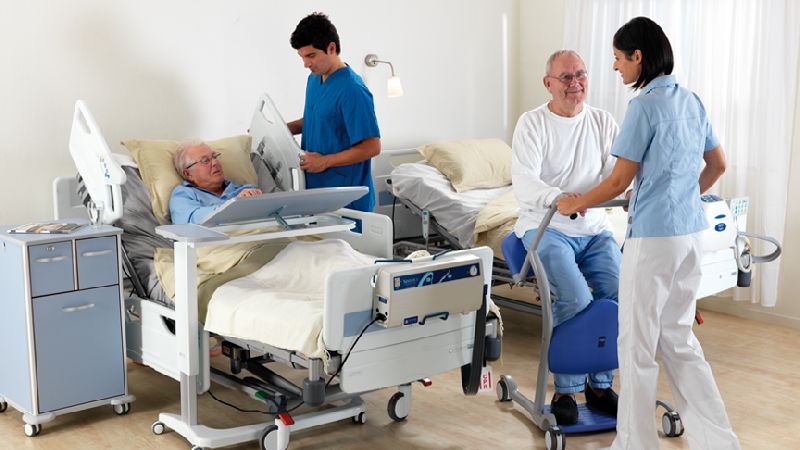The global patient handling equipment market was valued at $10.4 billion in 2022 and is projected to reach $14.0 billion by 2027, with a CAGR of 6.2% from 2022 to 2027. The latest report edition includes an updated market overview and assessments for all segments from 2020 to 2027, along with revised industry trends, technology analysis, pricing analysis, and patent analysis. It also considers the impact of an ongoing economic recession on market sizing and provides detailed qualitative insights on the recession’s regional effects. Market growth is primarily driven by the increasing geriatric and obese populations, the high risk of caregiver injuries from manual patient handling, rising hospital admissions, and the implementation of safety regulations for healthcare providers during patient lifting. However, inadequate training for caregivers on proper use of patient handling equipment is a significant hindrance to market growth.

Patient Handling Equipment Market
Market Dynamics
Drivers:
- Growing Geriatric and Obese Populations: The number of people aged 60 and above has been steadily increasing. This demographic is more susceptible to fall-related injuries, leading to functional disabilities and a dependence on mobility equipment. According to the WHO, by 2030, one in six people globally will be 60 or older, driving the demand for patient handling equipment.
Restraints:
- Lack of Training for Healthcare Providers: Effective training programs are essential to raise awareness about safe patient handling and prevent injuries. Without proper training, caregivers may revert to manual handling techniques, finding them more manageable than patient lifting equipment, thus limiting equipment adoption.
Opportunities:
- Increasing Demand for Home Healthcare Services: Government regulations aim to reduce healthcare treatment costs and durations, promoting nursing homes and home healthcare. With advancements in technologies like remote patient monitoring, the home care segment is expected to grow, increasing the demand for home care equipment such as mobility devices, patient transfer devices, and medical beds.
Challenges:
- Improper Architectural Designs of Healthcare Facilities: The physical environment in healthcare settings can restrict movement and positioning. Factors like facility design, access, and storage conditions should be based on evidence-based design to support staff and patient well-being.
Market Segmentation
By Type:
- Patient Transfer Devices: Expected to see the highest growth due to the rise in lifestyle diseases like obesity and the increasing preference for home care.
- Medical Beds
- Mobility Devices
- Stretchers and Transport Chairs
- Toilet Assist Equipment
By End Users:
- Hospitals: Largest share due to the increasing geriatric population, patient numbers, injuries during patient handling, and the number of disabled individuals.
- Home Care Settings
- Other End Users
By Region:
- North America: Second-largest share due to the growing number of elderly care facilities, hospitals, ambulatory centers, the rising geriatric population, and high healthcare expenditure.
Key Market Players
The patient handling equipment market is dominated by established players such as Arjo (Sweden), Baxter International Inc. (US), Savaria (Canada), Invacare Corporation (US), Stryker (US), Drive DeVilbiss Healthcare (US), Etac AB (Sweden), GF Health Products, Inc. (US), V. Guldmann A/S (Denmark), Joerns Healthcare LLC (US), Medline Industries, Inc. (US), Prism Medical UK Ltd. (UK), LINET (Czech Republic), Stiegelmeyer GmbH & Co. KG (Germany), Benmor Medical (UK), Malvetio Spa (Italy), and EZ Way, Inc. (US).
Recent Developments
- September 2022: Handicare expanded its portfolio with the Garaventa Lift range of wheelchair platform lifts and new products like the 4000 curved stairlifts.
- May 2022: Invacare launched Birdie Evo XPLUS, a patient lift for post-acute care with innovative technology for maximum comfort and security.
- March 2022: Stryker introduced the Multi-Position MATS Mobile Air Transfer System to prevent patient sliding during tilt procedures and protect nurses during lateral transfers.
- May 2021: Hill-Rom participated in the UBS Global Healthcare Virtual Conference to support its healthcare business.
Report Scope
- Market Revenue in 2022: $10.4 billion
- Estimated Value by 2027: $14.0 billion
- Growth Rate: CAGR of 6.2%
- Market Driver: Growing number of geriatric and obese populations
- Market Opportunity: Increasing demand for home healthcare services
- Geographies Covered: North America, Europe, Asia Pacific, Latin America, Middle East, and Africa
The report categorizes the market to forecast revenue and analyze trends in submarkets, including patient transfer devices, medical beds, mobility devices, and more, across various regions.
